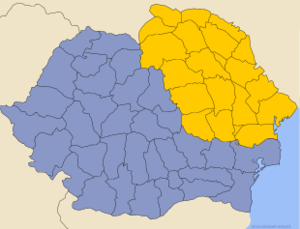Moldavia
|
|
Moldavia (Moldova in Romanian) was a Romanian principality, originally created in the Middle Ages, now divided between Romania, Moldovan Republic and Ukraine.
| Contents |
Geography
Moldavia was situated between the Carpathian Mountains and the Dniester River, the Prut river flows approximately through its middle from North to South.
The eastern part is called Bessarabia and is divided between Moldova and Ukraine. The north-eastern part is called Bukovina and is divided between Romania and Ukraine. The south-eastern part is named Budjak and is part of Ukraine.
History
See also History of Moldova
Moldavia west of Prut river united with Wallachia in 1859 as the principality of Romania. The parts of Moldavia situated East of Prut were occupied by Russia in 1812 and named Bessarabia; united with Romania in 1918; was reoccupied by the Soviet Union in 1940; recovered by Romania in 1941; reoccupied by the Soviet Union in 1944 and transformed into Moldavian SSR, and in 1991 declared independence as Moldova Republic.
The union between Eastern Moldavia and Romania was confirmed by the Treaty of Paris (1920), but this was not recognised by the Soviet Union. After World War II, parts of Eastern Moldavia were turned into the Soviet Socialist Republic of Moldavia, and its southern (Bugeac) and northern (north Bukovina) most parts were handed over to Ukraine. In 1991, the Moldavian SSR declared independence under the name "Moldova."
Historical Links
- The Princely Court of Stefan's son, Alexander, in Bacau (http://www.patzinakia.ro/wallachiamediaevalis/bacau-index.htm) - images, layouts (at the Romanian Group for an Alternative History Website (http://www.patzinakia.ro/))
- Original Doments (http://www.patzinakia.ro/documenta/index.htm) concerning both Moldavia and other Romania Principalities during the Middle Ages (at the Romanian Group for an Alternative History Website (http://www.patzinakia.ro/))
Name
The original name of the region was Bogdania, named after Bogdan I, founder of Moldavia. The names "Moldavia" and "Moldova" are derived from the name of the Moldova river, however the etymology is not known and there are several variants:
- from Latin mollis Davia, meaning gentle Dacia, referring to the fertility of its land
- Daco-Romanian "Molte-dava" ("Many cities"), however this does not follow the sound changes that would make the intervowel "v" disappear
- the old German "Molde", meaning "open-pit mine"
- a Slavic etymology ("-ova" is a quite common Slavic suffix), the meaning of which is unknown.
Population
The partition of Moldavia within Romania's borders has a population of 4,681,555 (2002), while the partition making up the country of Moldova has a population of 4,431,570 (2002). Data for the population of the partitions within Ukraine is unreliable, however it is estimated to be between 1,500,000 and 2,000,000 people. The estimated total for all partitions is over 10,500,000 people.
Coat of Arms of Romania
Moldavia is represented by an auroch in the Coat of Arms of Romania.
See also
| Romanian historical regions: |
| Dobrogea : Cadrilater
Moldavia : Bessarabia | Bugeac | Bukovina Transylvania : Banat | Crişana | Maramureş |
cs:Moldávie de:Fürstentum Moldau et:Moldova id:Moldavia ja:モルダヴィア ro:Moldova fi:Moldavia

